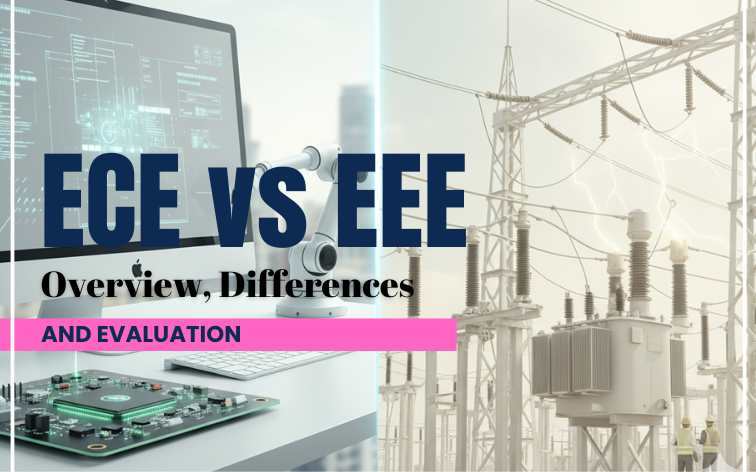ECE vs EEE: Overview, Differences and Evaluation
Students interested in electrical and electronic devices are often confused between choosing ECE and EEE. The main difference between ECE and EEE is that ECE is focused on small circuits, integrated circuits, and communication systems, while EEE includes larger circuits, power generation, distribution, and electrical machines. There are a variety of opportunities and future scope exist in both programs. Students can choose between ECE and EEE based on several factors like scope, interests, subject matter, applications and career opportunities. In this article, we have given a detailed account on the difference between ECE and EEE, which can allow the students to make a clear decision.
At Mahalakshmi Tech Campus, it does not matter whether you are building circuits, electronic devices or electrical machines, our engineering programs equip you to innovate and excel in your chosen domain.
ECE vs EEE – Overview
Before understanding the specific aspects that distinguish the ECE from EEE, we’ll delve into their definitions and the subject matter it covers to understand the essence of each branch of engineering.
ECE (Electronics and Communication Engineering)
ECE deals with designing and improving smaller electronic circuits and communication networks, involving work with microprocessors, semiconductors, wireless networks, and emerging technologies. This branch focuses on the intricate world of signal processing, data transmission, and communication protocols. ECE engineers are the architects behind smartphones, internet infrastructure, satellite communication systems, and embedded devices that power modern IoT ecosystems. The curriculum emphasizes digital signal processing, VLSI design, antenna theory, and network protocols. Students develop expertise in both hardware design and software implementation, making them versatile professionals capable of bridging the gap between physical devices and digital applications.
Learn more: ECE Engineering Scope
EEE (Electrical and Electronics Engineering)
EEE deals with power generation, electrical systems, and core electronics, focusing on the generation, transmission, distribution, and utilization of electrical power. This branch covers everything from massive power plants to household electrical systems. The functions of EEE engineers are designing electrical grids, developing renewable energy solutions, creating efficient motors and generators, and ensuring safe power distribution across communities. The curriculum has power systems analysis, electrical machines, control systems, and power electronics. These professionals are essential for maintaining and modernizing electrical infrastructure, developing sustainable energy solutions, and ensuring reliable power supply for industries and communities.
Learn more: EEE Engineering Scope
What are the Differences Between ECE and EEE?
The differences between ECE and EEE can be evaluated across several key aspects: basic principles, scope of work, practical applications, career trajectories, and future growth potential. Let’s get into each aspect in detail.
ECE vs EEE: Basic Principles
The fundamental approach and underlying principles distinguish these two engineering branches significantly.
ECE operates on the principles of information theory, signal processing, and electromagnetic wave propagation. The core philosophy revolves around converting real-world phenomena into digital signals, processing these signals for meaningful information extraction, and transmitting this information efficiently across various media. Engineers work with concepts like modulation, demodulation, filtering, amplification, and digital signal processing algorithms. The mathematical foundation includes Fourier analysis, probability theory, and complex analysis. Design principles emphasize miniaturization, low power consumption, high-speed processing, and reliable data transmission.
EEE is grounded in electromagnetic theory, thermodynamics, and power system analysis. The fundamental principles focus on energy conversion, power flow control, and system stability. Engineers apply concepts of electrical machines theory, power electronics, and control systems to manage large-scale electrical energy. The mathematical foundation includes differential equations, linear algebra, and optimization theory. Design principles emphasize efficiency, reliability, safety, and cost-effectiveness in power generation, transmission, and distribution systems.
ECE vs EEE: Scope & Interest
The scope and areas of interest vary significantly, with each offering unique opportunities for specialization and growth.
ECE has a significantly broader scope, particularly with VLSI being the next big technological frontier, driven by explosive growth in AI chips, 5G hardware, and IoT applications. VLSI careers in 2025 present compelling opportunities with the global semiconductor industry expanding rapidly and high demand for skilled VLSI engineers, especially with the rise of AI chips and edge computing requiring specialized designs. If you have interests in chip design, embedded systems, wireless communication, or software-hardware integration, ECE is the ideal choice. The field offers specializations in areas like RF engineering, digital signal processing, VLSI design, embedded systems, and telecommunications. Current trends include AI acceleration, IoT devices, and high-performance computing applications.
EEE offers substantial scope in power systems, renewable energy, and industrial automation. The growing emphasis on sustainable energy and smart grid technologies has expanded opportunities significantly. If you’re interested in large-scale systems, power generation, electrical machinery, or contributing to environmental sustainability through clean energy solutions, EEE is more suitable. Specialization areas include power system analysis, renewable energy systems, electric vehicles, power electronics, and industrial drives. The field is experiencing growth due to the global transition toward renewable energy and electrification of transportation.
ECE vs EEE: Applications
Real-world applications demonstrate the practical impact and industry relevance of each branch.
ECE applications span consumer electronics, telecommunications, healthcare technology, and emerging digital infrastructure. Key applications include smartphone and tablet development, 5G network infrastructure, satellite communication systems, medical imaging devices like MRI and CT scanners, Internet of Things devices, automotive electronics, and cybersecurity systems. Emerging applications include 5G technology integration, three-dimensional integrated circuits (3D ICs), and beyond-CMOS technologies. The field also contributes to artificial intelligence hardware, quantum computing research, and advanced driver assistance systems (ADAS).
EEE applications focus on power infrastructure, industrial systems, and energy management. Major applications include power plant design and operation, electrical grid management, renewable energy systems (solar, wind, hydroelectric), electric vehicle charging infrastructure, industrial motor drives, smart home automation systems, and energy storage solutions. The field plays a crucial role in developing sustainable energy technologies, improving power system efficiency, and ensuring reliable electricity supply for modern society.
ECE vs EEE: Career Opportunities
Career prospects and industry demand vary significantly between these branches, each offering distinct professional pathways.
ECE offers a more diverse range of career paths in telecommunications, electronics, and communication systems. ECE professionals have an edge in international markets due to demand for AI, embedded systems, and chip design, with starting salaries ranging from ₹4-10 LPA in India, especially in software roles. Career opportunities include positions at technology giants like Intel, Qualcomm, Broadcom, Samsung, Apple, Google, Microsoft, and telecommunications companies like Ericsson, Nokia, and Huawei. Emerging opportunities exist in startups focusing on IoT, AI hardware, and semiconductor design. Professional roles include VLSI design engineer, embedded systems developer, telecommunications engineer, RF engineer, and product development engineer.
EEE opens doors to careers in power systems, energy management, and electrical design. EEE professionals have opportunities in energy companies and power grids. Career paths include positions with power utilities like NTPC, BHEL, Siemens, ABB, Schneider Electric, General Electric, and renewable energy companies. Government sectors offer opportunities in power grid corporations and regulatory bodies. Professional roles include power systems engineer, electrical design engineer, energy consultant, project manager in power sector, and renewable energy specialist.
ECE vs EEE: The Future
Future growth prospects and technological evolution will significantly impact career trajectories in both fields.
The future of ECE is exceptionally promising with multiple technological revolutions converging. The demand for skilled VLSI professionals continues to surge, driven by AI chips, 5G hardware, and IoT applications, with companies racing to develop smaller, faster, and more energy-efficient chips. Emerging technologies like 6G networks, quantum computing, neuromorphic chips, and advanced AI hardware will create unprecedented opportunities. The semiconductor industry’s growth, particularly in India’s emergence as a global hub, promises extensive career prospects. Areas like edge computing, autonomous vehicles, and smart city infrastructure will require specialized ECE expertise.
The future of EEE is equally promising, driven by the global energy transition and electrification trends. The push toward renewable energy, electric vehicles, and smart grids is creating substantial demand for EEE professionals. Climate change mitigation efforts, energy storage technologies, and grid modernization projects will provide long-term career stability. The integration of artificial intelligence in power systems, development of micro-grids, and advancement in power electronics for renewable energy integration offer exciting opportunities. The electrification of transportation and industrial processes will continue driving demand for EEE expertise.
Read What to do after Graduation in Engineering? and gain more clarity about your career progression and the future.
ECE vs EEE: Summary Overview
Understanding the key differences helps in making an informed decision about your engineering career path.
|
Aspect |
ECE (Electronics & Communication Engg.) |
EEE (Electrical & Electronics Engg.) |
|
Focus Area |
Information & Communication Systems |
Power Generation & Distribution |
|
Key Technologies |
VLSI, 5G, IoT, Embedded Systems |
Power Systems, Renewable Energy, Motors |
|
Mathematical Foundation |
Signal Processing, Information Theory |
Power System Analysis, Control Theory |
|
Industry Sectors |
Telecom, Semiconductor, Software |
Power Utilities, Energy, Manufacturing |
|
Salary Range (India) |
₹4–10 LPA (higher in software roles) |
₹3–8 LPA (stable growth) |
|
Global Opportunities |
High (AI, Chip Design, Telecom) |
Moderate (Energy, Power Projects) |
|
Future Growth |
Very High (VLSI, AI, 5G) |
High (Renewable Energy, Smart Grids) |
|
Specialization Options |
VLSI, RF, DSP, Embedded, Telecom |
Power Systems, Renewable Energy, Control |
|
Career Flexibility |
High (Hardware + Software roles) |
Moderate (Primarily hardware-focused) |
Check out: Top EEE Colleges in Chennai
Which is Better between ECE and EEE?
Both ECE and EEE have unique career opportunities depending on your interest and skills. ECE engineers typically receive better salary packages than EEE engineers, but selecting between ECE and EEE entirely depends on the area of interest. ECE offers broader scope with higher flexibility, particularly advantageous for those interested in cutting-edge technology, software-hardware integration, and global career opportunities. The semiconductor boom and VLSI industry growth provide exceptional prospects. However, EEE offers stability, essential infrastructure development opportunities, and the satisfaction of contributing to society’s power needs and environmental sustainability.
Which is the Best College to Pursue ECE and EEE?
Mahalakshmi Tech Campus is the best choice for engineering aspirants seeking excellence in electronics and electrical engineering fields. With cutting-edge laboratories, industry-experienced faculty, and a stellar placement record, the college provides many opportunities whether you choose our ECE course or EEE course. The campus combines theoretical rigor with practical application, ensuring graduates are industry-ready from day one. Join thousands of successful alumni who’ve launched thriving careers from this premier engineering institution that signified for its academic excellence and career success.





